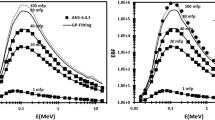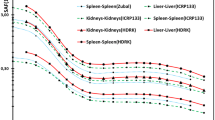Abstract
The photon buildup factors have been proposed to consider the produced secondary photon sources during the interactions of γ-rays with the material. In the study of γ-ray dosimetry and γ-ray shielding, different photon buildup factors have been introduced, including number buildup factor, exposure buildup factor (EBF) and energy absorption buildup factor (EABF). In the present study, a new type of buildup factor, energy transfer buildup factor (ETBF), was calculated and compared with EABF. To the best of the authors’ knowledge, the ETBF has not been calculated so far. The calculations were carried out for 1–20 MeV photons in soft tissue, lung, brain and water up to the depth of 10 mean free path (MFP) using MCNP6.1. While comparing the ETBF and the EABF, it was found that the relative difference between the ETBF and the EABF was increased by increasing the photon energy and MFP. To be specific, the relative difference between the ETBF and the EABF in the soft tissue for 1 MeV photon was in the range of 0–0.19%, while it was in the range between 1.5 and 2.86% for 20 MeV photon. In addition, to interpolate the ETBF, the parameters of the G-P fitting formula were determined. For validation, the values of ETBF and EABF were calculated in water and soft tissue, respectively and a good agreement was observed with the obtained values from the FLUKA code and MCNP5 code. Finally, it can be stated that the calculation of the ETBF for high photon energies leads to useful and practical results in dosimetry and shielding design of γ-rays.








Similar content being viewed by others
References
G R White, Phys. Rev. 80, 154 (1950), https://doi.org/10.1103/PhysRev.80.154
U Fano, Nucleonics 11, 9 (1953), https://www.osti.gov/biblio/4422059
Y Harima, Radiat. Phys. Chem. 41, 4 (1993), https://doi.org/10.1016/0969-806X(93)90317-N
H Goldstein and J E Wilkins Jr, Calculations of the penetrations of gamma rays (NSA-09-002472, United States, 1954), https://doi.org/10.2172/4394676
C M Eisenhauer and G L Simmons, Nucl. Sci. Eng. 56, 3 (1975), https://doi.org/10.13182/NSE75-A26739
A B Chilton, C M Eisenhauer and G L Simmons, Nucl. Sci. Eng. 73, 1 (1980), https://doi.org/10.13182/NSE80-A18714
K Takeuchi and S Tanaka, PALLAS-PL, SP-Br: a code for direct integration of transport equation in one-dimensional plane and spherical geometries (JAERI-M--9695, Japan, 1981), https://doi.org/10.11484/jaeri-m-9695
K Takeuchi and S Tanaka, PALLAS-1D(VII): A code for direct integration of transport equation in one-dimensional plane and spherical geometries (JAERI-M-84-214, Japan, 1984), https://inis.iaea.org/search/search.aspx?orig_q=RN:16086506
D V Gopinath, K V Subbaiah and D K Trubey, Nucl. Sci. Eng. 97, 4 (1987), https://doi.org/10.13182/NSE87-A23519
H Hirayama and D K Trubey, Nucl. Sci. Eng. 99, 2 (1988), https://doi.org/10.13182/NSE88-A23555
K V Subbaiah, A Natarajan and D V Gopinath, Nucl. Sci. Eng. 101, 4 (1989), https://doi.org/10.13182/NSE89-A23624
ANSI\(/\)ANS-6.4.3-1991, Gamma-ray attenuation coefficients and buildup factors for engineering materials (American Nuclear Society, La Grange Park, 1991), https://webstore.ansi.org/Standards/ANSI/ansians1991-1534182
O Chibani, Nucl. Sci. Eng. 137, 2 (2001), https://doi.org/10.13182/NSE01-A2187
J C Ryman et al, Trans. Am. Nucl. Soc. 99, (2008)
L P Ruggieri, Update to ANSI\(/\)ANS-643-1991 for high-Z materials and review of particle transport theory (UNLV Retrospective Theses & Dissertations, 2427, 2008), https://doi.org/10.25669/xc1i-qbff
L Durani, Update to ANSI\(/\)ANS-6.4.3-1991 for low-Z and compound materials and review of particle transport theory (UNLV Theses, Dissertations, Professional Papers and Capstones, 43, 2009), https://doi.org/10.34917/1363554
C E Sanders, Proceedings Paper, ICONE18-30212 (2010), https://doi.org/10.1115/ICONE18-30212
N Tsoulfanidis and S Landsberger, Measurement and detection of radiation (CRC Press, New York, 2015), https://doi.org/10.1201/b18203
R Khabaz, Eur. Phys. J. Plus 137, 344 (2022), https://doi.org/10.1140/epjp/s13360-022-02550-9
O Kadri and A Alfuraih, Appl. Sci. 12, 2 (2022), https://doi.org/10.3390/app12020798
M I Sayyed, M Y Hanfi, K A Mahmoud and A Abdelaziem, Optik 258, 168851 (2022), https://doi.org/10.1016/j.ijleo.2022.168851
I Akkurt and R B Malidarre, Radiat. Phys. Chem. 193, 109958 (2022), https://doi.org/10.1016/j.radphyschem.2021.109958
D Sardari, S Baradaran, F B Mofrad and N Marzban, Appl. Radiat. Isot. 183, 110150 (2022), https://doi.org/10.1016/j.apradiso.2022.110150
E Sakar et al, Radiat. Phys. Chem. 166, 108496 (2020), https://doi.org/10.1016/j.radphyschem.2019.108496
M Kurudirek and Y Kurucu, Radiat. Eff. Defects Solids 175, 7 (2020), https://doi.org/10.1080/10420150.2020.1737694
M Dong et al, Prog. Nucl. Energy 146, 104155 (2022), https://doi.org/10.1016/j.pnucene.2022.104155
H M H Zakaly et al, J. Mater. Res. Technol. 18, 1424 (2022), https://doi.org/10.1016/j.jmrt.2022.03.030
I O Olarinoye et al, Heliyon 5, 7 (2019), https://doi.org/10.1016/j.heliyon.2019.e02017
K S Mann and S S Mann, Ann. Nucl. Energy 150, 107845 (2021), https://doi.org/10.1016/j.anucene.2020.107845
D Sardari, A Abbaspour, S Baradaran and F Babapour, Appl. Radiat. Isot. 67, 7 (2009), https://doi.org/10.1016/j.apradiso.2009.02.033
H Hirayama, J. Nucl. Sci. 32, 12 (1995), https://doi.org/10.1080/18811248.1995.9731842
I Jarrah et al, Radiat. Phys. Chem. 160, 15 (2019), https://doi.org/10.1016/j.radphyschem.2019.03.008
A Angelopoulos et al, Phys. Med. Biol. 36, 6 (1991), https://doi.org/10.1088/0031-9155/36/6/005
K Moshkbar-Bakhshayesh, S Mohtashami and M Sahraeian, Ann. Nucl. Energy 152, 108023 (2021), https://doi.org/10.1016/j.anucene.2020.108023
D Sardari, S Saudi and M Tajik, Ann. Nucl. Energy 38, 2 (2011), https://doi.org/10.1016/j.anucene.2010.09.007
H Kharrati, A Agrebi and Mohamed-Karim Karaoui, Med. Phys. 34, 4 (2007), https://doi.org/10.1118/1.2710333
A Das and T Singh, Radiat. Phys. Chem. 194, 110028 (2022), https://doi.org/10.1016/j.radphyschem.2022.110028
A Das, A Ray and T Singh, Radiat. Phys. Chem. 196, 110122 (2022), https://doi.org/10.1016/j.radphyschem.2022.110122
O Kadri and A Alfuraih, Nucl. Sci. Tech. 30, 176 (2019), https://doi.org/10.1007/s41365-019-0701-4
A A Alfuraih and O M Kadri, Dose-Response (2022), https://doi.org/10.1177/15593258211068621
M M Rafiei and H Tavakoli-Anbaran, J. Radiol. Prot. 38, 1 (2018), https://doi.org/10.1088/1361-6498/aa9cfa
M M Rafiei and H Tavakoli-Anbaran, Eur. Phys. J. Plus 133, 548 (2018), https://doi.org/10.1140/epjp/i2018-12355-8
M M Rafiei, S Parsaei and M Kurudirek, JINST 15, T11004 (2020), https://doi.org/10.1088/1748-0221/15/11/T11004
M M Rafiei, H Tavakoli-Anbaran and M Kurudirek, Radiat. Phys. Chem. 177, 109118 (2020), https://doi.org/10.1016/j.radphyschem.2020.109118
P Kaur et al, J. Phys. Chem. Solids 150, 109812 (2021), https://doi.org/10.1016/j.jpcs.2020.109812
E Kavaz et al, Int. J. Radiat. Biol. 92, 7 (2016), https://doi.org/10.1080/09553002.2016.1175681
H H Saleh, J M Sharaf and R S Abady, Appl. Radiat. Isot. 167, 109464 (2021), https://doi.org/10.1016/j.apradiso.2020.109464
Y Harima et al, Nucl. Sci. Eng. 94, 1 (1986), https://doi.org/10.13182/NSE86-A17113
M S Al-Buriahi et al, Prog. Nucl. Energy 137, 103763 (2021), https://doi.org/10.1016/j.pnucene.2021.103763
S S Obaid et al, Radiat. Phys. Chem. 148, 86 (2018), https://doi.org/10.1016/j.radphyschem.2018.02.026
H O Tekin et al, Mater. Res. Express 6, 11 (2019), https://doi.org/10.1088/2053-1591/ab4cb5
K I P Kartha et al, Am. J. Roentgenol. 96, 1 (1966), https://doi.org/10.2214/ajr.96.1.66
L L Meisberger et al, Radiology 90, 5 (1968), https://doi.org/10.1148/90.5.953
A Shimizu, T Onda and Y Sakamoto, J. Nucl. Sci. 41, 4 (2004), https://doi.org/10.1080/18811248.2004.9715503
N Kucuk, Expert Syst. Appl. 37, 5 (2010), https://doi.org/10.1016/j.eswa.2009.11.047
A B Chilton, J K Shultis and R E Faw, Principles of radiation shielding (Prentice Hall, London, 1984), https://inis.iaea.org/Search/search.aspx?orig_q=source:%22ISBN%200-13-709907-X%22
T Goorley et al, Nucl. Technol. 180, 3 (2012), https://doi.org/10.13182/NT11-135
D R White et al, ICRU Report 44, J ICRU os-23, 1 (1989), https://journals.sagepub.com/toc/crub/os-23/1
J H Hubbell and S M Seltzer, Tables of X-ray mass attenuation coefficients and mass energy-absorption coefficients from 1 keV to 20 MeV for elements Z = 1 to 92 and 48 additional substances of dosimetric interest (NIST, NISTIR 5632, 2004), https://doi.org/10.18434/T4D01F
D B Pelowitz, MCNP6TM User’s Manual Version 1.0 LA-CP-13-00634, Rev. 0 (Los Alamos National Laboratory, 2013), https://mcnp.lanl.gov/mcnp_manual.shtml
Website: https://fluka.cern
C Ahdida et al, Front. Phys. 9, 788253 (2022), https://doi.org/10.3389/fphy.2021.788253
G Battistoni et al, Ann. Nucl. Energy 82, 10 (2015), https://doi.org/10.1016/j.anucene.2014.11.007
F H Attix, Introduction to radiological physics and radiation dosimetry (Wiley-VCH Verlag GmbH, Mörlenbach, 2004), https://doi.org/10.1002/9783527617135
H Cember and T E Johnson, Introduction to health physics 4th Edn (McGraw-Hill Medical, New York, 2009),
P D Higgins et al, Mass energy-transfer and mass energy-absorption coefficients, including in-flight positron annihilation for photon energies 1 keV to 100 MeV (NISTIR 4812, 1991), https://www.osti.gov/biblio/5888257-mass-energy-transfer-mass-energy-absorption-coefficientsincluding-flight-positron-annihilation-photon-energies-kev-mev.
M M Rafiei and S Parsaei, JINST 16, T10005 (2021), https://doi.org/10.1088/1748-0221/16/10/T10005
Author information
Authors and Affiliations
Corresponding author
Rights and permissions
About this article
Cite this article
Mohammad Rafiei, M., Noori, H., Parsaei, S. et al. Determination of γ-ray energy transfer buildup factor in water and some human tissues using Monte Carlo simulation. Pramana - J Phys 97, 131 (2023). https://doi.org/10.1007/s12043-023-02611-3
Received:
Revised:
Accepted:
Published:
DOI: https://doi.org/10.1007/s12043-023-02611-3
Keywords
- Energy transfer buildup factor
- energy absorption buildup factor
- γ-ray shielding
- γ-ray dosimetry
- MCNP6.1




